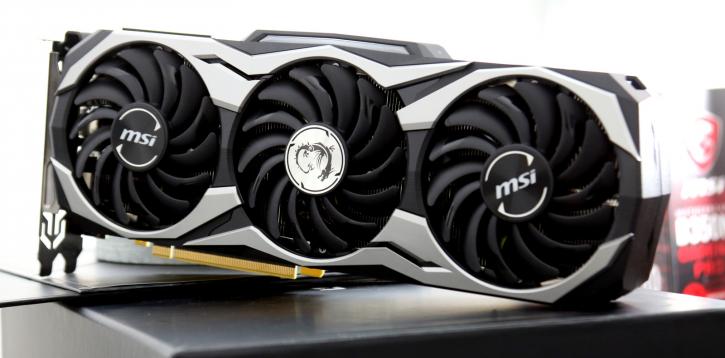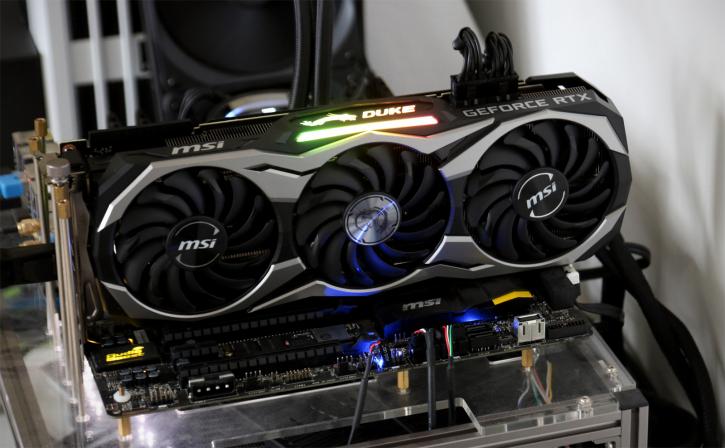Conclusion
Conclusion
Well daumn, I quite honestly didn't expect the DUKE to be as good as the TRIO. All the variables are really good, two thumbs up man. I mean if we set aside the price discussion and the lack or anything RT and purely focus on what MSI has brought to the market, then this duke ain't a hazard! (pardon the Dukes of hazard pun). So yeah, this duke is the new king (and another pun, thank you). It's a little weird, this card is pretty much dead on at the same performance level as the TRIO, it's boost frequency, however, is ~100 MHz lower. Thing is, MSI increased the power limiter, and that makes both the Trio and Duke however in that 1900 MHz range. Once games start to stress the GPU, the voltage and power limiters kick in, ergo they perform the same (roughly). You are going to notice this with pretty much all the brands what apply this trick. That said, MSI is one of the few that is ballsy enough to tweak the card on power limiter and frequency at a significant level. And while that won't move mountains in performance, it certainly makes them perform the fastest. I think I've said enough about pricing and RT/Tensor in general so I'll leave theta discussion as is. This conclusion I like to focus on what MSI actually did with the hardware. And yeah it's good, lots of power phases, it's not running hot, the acoustics are really okay and above it all, this is just a properly good looking GeForce RTX 2080 Ti. MSI I gonna slap me in the face with a Molex connector me for saying it, but I like the Duke over the TRIO, bigtime.
DX-R gaming and DLSS
So here my standard snippet on it: I would have loved to show you some DXR (Raytracing) performance, but all that NVIDIA provided was an internal Star Wars Reflection demo you've probably already seen, which is lovely to see!, but simply is irrelevant of course to benchmark. Also, very cool that UL contacted us and allowed us to test and showcase where they are at with the Raytracing demo. You have seen an exclusive there, work in progress though! So yeah, that's it for Raytracing for now. Once we actually see games release them and once Microsoft releases DX-R (fall update) we'll create some additional content to show you the potential of the new RT cores as really, this release is all about the RT cores my jolly good friends. So I am not dismissing the RT cores here, as honestly, I am super excited about the technology and what it can do for image quality in gaming. It's just that I objectively cannot comment or give you an advise based on something we cannot test in an actual game (which what this is all about eh?). That other feature then, Deep learning Supersampling. Totally lovely, really .. but here again we've been dealing with the fact that there is no software to test aside from precisely two titles, you've seen the results and image quality in this article with the help of Ultra HD videos. I'll say this though, despite we've only been able to visually inspect and measure one title, we are impressed by the technology as when you use DLSS, you don't need to enable AA in your shader engine anymore as DLSS takes care of that for you by using the Tensor cores, so that's completely offloaded and that brings in a good chunk of additional performance in return, that you'd normally miss out on. The technology in its current state, I can confirm that it is impressive. And with that out of the way, I need to close the primary new features and that DNA that is RTX and AI already and turn back to traditional rasterized shading. More relevant would be the EPIC infiltrator DLSS demo I showed you? I meant that's really good right? Plus it just runs much faster compared to TAA, that's win-win right there.
Gaming performance
Face it, the RTX 2080 Ti is a beast. We're seeing some caps at lower resolution gaming, but for Ultra HD, the next step in performance has been made. Depending on title and workload you'll see 25% to maybe even 40% performance increases in this specific resolution. The RTX 2080 Ti really starts to flex muscle at or after a resolution of 2560x1440, anything below is normalized due to driver and processor bottlenecks. We cannot think of a game that won't run really good combined with the best image quality settings. The more difficult you make it on this card, the better it'll perform compared to last-gen products. Gaming you must do with at least a 24" monitor of course, at 2560x1440/1600 or better would be a nice fit. The 11 GB graphics memory is excellent, making the product very future proof. In terms of multi-GPU setups, Turing will support 2-way SLI, but really that's it and all. NVIDIA did not have the new NVLINK connector available, so we've not been able to test it.
Aesthetics
yeah, I think I spilled the beans already here, haven't I? It's personal as aesthetics are just that, but out of all the cards I've had my hands on (and ironically it actually quite a few even after two days of the founders release!), I like this one the best. The slim design appeals to me, the two tones black/grey design is great and the embedded RGB top side logo is simply put aesthetically pleasing (and if you dislike R to the B to the G, just disable it, my man). Backplates, sorry it's can't be all praise and hallelujah! I dislike closed backplate designs for the simple reason it can trap heat and thus warm up the PCB. Closed however can look better and can protect your PCB and components from damage and dust. Other than that on the looks, she's got them. You get a nice quality feel of comprehensive aesthetics and quality
Cooling & Noise Levels
Pretty good. The card tops out at roughly 73~74 Degrees C while gaming and you need to keep in mind that this is a factory tweaked product with increased power limiter. So that's not bad at all, especially considering the acoustics as this puppy remains savvy at normal to silent noise levels. We measured a 38 sometimes hitting the 39 DBa range which means you can hear the product but only softly. Considering a GPU with a die size of 754 mm² and a freakishly high 18.6 Billion transistors, hey I'm down with it.
Power Consumption
Any TU102 Turing GPU and thus graphics cards based on them are rated at roughly 260 Watt TDP under full stress. MSI, however, gave the boost clock 1665 MHz and increased that power limiter a bit, and that raises the TDP. We measured 298 Watts when gaming, which is 38 Watts over reference. If you are bothered by that, so be it. But if you would manually tweak a 2080 Ti yourself, you get the very same thing. A 650 Watt PSU would be a nice match for these cards but 700 Watts probably is better to be on the safe side. Remember - when purchasing a PSU, aim to double up in Wattage as your PSU is most efficient when it is at 50% load. Here, again, keep in mind we measure peak power consumption, the average power consumption is a good notch lower depending on GPU utilization. Also, if you plan to overclock the CPU/memory and/or GPU with added voltage, please do purchase a power supply with enough reserve. People often underestimate it, but if you tweak all three aforementioned variables, you can easily add 150 Watts to your peak power consumption budget as increasing voltages and clocks increase your power consumption.
Overclocking
While the Duke is factory tweaked for you, it simply has a lot more potential. If you max out the power limiter and voltage you'll be able to add anything 125~145 MHz on that GPU. The memory ran at +1000 (=16000 Mhz effective), that's a golden move to make as well. With these settings, you'll hover at a ~2050 MHz boost and have plenty of memory bandwidth, and that will increase your performance. With a maxed out tweak, you are looking at another 7~8% extra perf coming from the factory tweak.
The new OC Scanner
With each card that I am throwing at the OC Scanner, I get more excited about it. If you follow the step-by-step instructions I just gave you, the curved tweak is the better way to go. We have been able to nearly match the manual tweak in performance. The curved tweak is safer, easier on the GPU and pretty much guaranteed to be a stable overclock as the frequency curves align up perfectly with the voltage on a per point bases, it is impressive very promising and be sure to give it a try as we worked really hard on it in the development of Afterburner (and both Unwinder and myself are very proud of this).
Concluding
The Duke is the new King, I made a pun about it, but it's also the truth. Out of all the RTX cards I've had my hands on, I liked this one the best. It is the combination of refinement in design, looks, and hardware. That said, all cards and brands will be close towards each other when looking at performance. The regulated limiters that NVIDIA applies will make sure of that, this card performance wise, however, is in that top 2, add the Duke series my friends .. is actually the more affordable model from MSI (if you allow me to use the word affordable here in this range for a second lol).
Once again I would like to remind you that this is a long card due to that cooler, please do make sure it actually fits inside your chassis. Other than that the card is properly built and when looking at the PCB and components, I merely see quality. Your gaming GPU temperature will sit at that 73~74 Degrees C threshold which is totally fine. Please do make sure your PC chassis offers good airflow as that is a must for any enthusiast class card.
The 2080 Ti seen from a 1080 Ti purely based on shading performance is impressive, but the big question remaining is that extra 25 to 40% extra performance worth the price tag? Purely based on rasterized/shaded game performance I would say no. The extra money needs to be found in the RT and Tensor cores, thus raytracing, DLSS and everything new that will follow from the new cores. DLSS I am savvy about, at least from what I have seen at the NVIDIA event and here with FFXV, so that is a limited scope of software to form an objective opinion on. Currently, I, however, do not know if the number of RT cores are fast enough or plentiful enough to be able to produce fast enough numbers for hardware-assisted ray tracing in rasterized games, and that is my biggest dilemma for this conclusion. I will say this though, Raytraced gaming blew me away when I briefly tested it on the NV event. It is the dawn of a new era and likely the path that defines the next decade of gaming. But we need games to support it before we can say anything solid about it. You've seen the numbers, for Ultra HD gamers this product works out well, really well.
Right, it's time to round things up. The Duke matches the Trio in performance, so basically go for what suits your budget and looks. Temps and acoustics are also very close towards each other. You have seen the thermal images, these show good decent results as the card throughout all locations remains at relatively proper temps. If you can pick it up for the right price then we can wholeheartedly recommend it, but yeah well .. I think I said enough about that. For now we need Raytracing and DLSS gaming titles for this product to make more sense (as that's where the extra cash is spent and to be found), in the upcoming month though we should see a decent number of hybrid Raytraced games, we think the adoption of DLSS will go faster (which is a really solid feature bringing you good AA at virtually no rendering cost).
The MSI GeForce RTX 2080 Ti DUKE is this is a stunning card that ticks all the right boxes aside from the general price level of course. For the ones that are willing, and can afford it this should be a serious entry on your short-list. And for these guys, this product is absolutely recommended. As mentioned due to pricing and RTX lacking in gaming we keep all awards at recommended at best. But I really want to give this card a top pick award based on design and likeability.
Recommended Downloads
- Sign up to receive a notice when we publish a new article
- Or go back to Guru3D's front page




